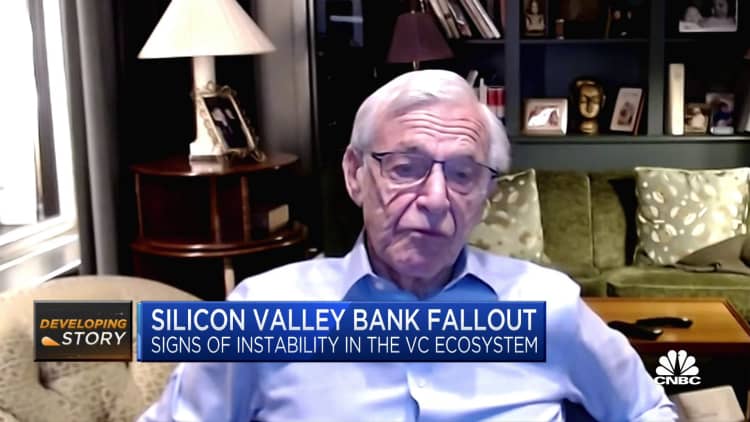In the short-term, regulators have found a solution for Silicon Valley Bank depositors and, we hope, calmed the fears of a wider run on regional banks. Now, attention will shift to the longer-term crisis facing the global system for financing innovation. The much admired U.S. system for producing innovation has just received a body blow, and the turmoil that led to the death of Silicon Valley Bank isn't over.
We are here as two women working in tech and finance to call for a serious examination of the financing needs of today's innovators — in the medium-term as they struggle to survive the current turmoil, and in the long term as they develop the innovations that result in economic growth.
Silicon Valley Bank, founded in 1983, was born in a time when Silicon Valley was a synonym for "tech" and "innovation." This is no longer the case. Over the past 50 years, the tech community has evolved into a global system that supports many different kinds of innovation. SVB was the crown jewel of banks and the venture capital industry, not just in Silicon Valley, but globally.
The huge venture funds and $100-million startups based in California still get attention, but investors and tech companies around the world look far different from this stereotype. They are mainly small business owners, who are in turn often stalwart employers and supporters of their communities.
Geographically, this community is widespread. In the Midwest, former Rust Belt and Southern United States, where Silicon Valley and its bank were held up as exemplars, there are likely hundreds of companies and venture capital funds with accounts and loans at the bank, and many more at other mid-size banks. Small, specialized and mid-size banks are often better at giving small business owners financial products and introducing them to others who might help them. They can also provide more industry-specific guidance.
With a decline in overall venture capital funding, the concurrent rise in interest rates and the uncertainty of the current climate, paths to growth and expansion for small businesses will dim. The prospects today are challenging for tech entrepreneurs because their businesses are inherently risky to begin with. Market fluctuations can impact their journeys quickly and very significantly.
What the tech startup community actually looks like
Though tech startups that get millions of dollars in finance are the ones in the headlines, the vast majority of tech firms run on a shoestring budget. Collectively, they employ millions of people. Two years ago researchers at the University of North Carolina and the National Venture Capital Association found 3.8 million employees at firms that received venture investment between 1990 and 2020 — 62.5% of them were outside California, Massachusetts and New York.
Startups and venture funds that we personally know in Upstate New York and Massachusetts are depositors in SVB; these communities are far from the more famous tech communities of Palo Alto or San Francisco.
Some 2,500 venture capital firms had accounts at SVB. It's easy to picture these as large firms, and a tiny handful of famous venture firms have hundreds of employees. But the median venture firm in the United States had $56 million in assets, according to the National Venture Capital Association, investing the money in startups on behalf of wealthy individuals and funds. That median size means many firms have revenue under $1 million.
Angel investors and operators also banked extensively at SVB; those operations – mostly solo businesses – are much smaller.

An unknown, but probably fairly large, percentage of Silicon Valley's account holders are startups and venture funds in tech markets in other countries, where tech startups are seen as integral to prosperity and economic growth. Many venture capital funds and startups from emerging markets trusted Silicon Valley Bank with their deposits and as their lender out of a belief that their money was in a well-regulated economy with credibility. Yesterday, the CEO of a company called Chipper Cash wrote about how important Silicon Valley Bank had been in its journey.
"A little known fact is that 5 years ago when I was trying to open Chipper's first bank account, SVB was the only bank that would accept us. I know there are countless other startups all doing very important work who would say the same thing," wrote the CEO, Ham Serunjogi. Chipper Cash makes it easier to send money across borders, working on the African continent.
Even further away from Silicon Valley are tech communities in Egypt, the UK, Botswana, Kenya and Nigeria, places that depend more than ever on technology innovation. We also know founders there who are beginning to wonder about the security of the U.S. financial system. The facilities and quick action from the U.S. government helped, but entrepreneurs from emerging markets now have fewer options in an already tight funding market.
Short-term losses
SVB functioned differently than a traditional bank. Focused on the tech industry, the bank was a venue for entrepreneurs, and founders flocked to SVB for much more than startup financing. The bank provided opportunities for venture capitalists and entrepreneurs to meet, creating invisible yet vital webs of human connection. It made quick turnarounds on mortgages; larger and more traditional banks are often reluctant to approve mortgages for entrepreneurs, even experienced ones. Silicon Valley Bank's employees guided and mentored founding teams on growing businesses, invested in startups, and supported the venture capitalists who collaborated with them.
Techstars, one of the largest pre-seed investors in the world, has stakes in portfolio companies valued at $96 billion in market capitalization. The franchise has managers and founders who banked exclusively at SVB. Y Combinator, a startup accelerator, has said one-third of startups with exposure to Silicon Valley Bank used SVB as their sole bank account. Both of these investor-accelerators likely used Silicon Bank because of its specialized tools, network and knowledge.
In fact, countries around the world try to replicate the United States' innovation infrastructure. According to recent reports, the government is still trying to find a buyer for key SVB units in an auction process. If important elements of SVB aren't brought under the wing of a larger institution with that specialized knowledge of tech and finance intact, the United States will have to support rebuilding something like it, if it hopes to continue producing innovation at a high level.
Long-term effects on innovation
The United States gained an edge on innovation starting in the 1950s, when the U.S. federal government poured money into research and development following the Soviet Union's launch of Sputnik. The result was the development of the silicon chip. Venture capital (and later, seed and angel investing) sprang up as an industry to provide the particular kind of risk capital required to fund people with ideas who weren't necessarily experienced at running businesses. This entire system of finance is designed around the idea that because it is so difficult to push an innovation all the way to market, the innovators need specialized help.
This kind of finance has helped produce very large companies, including Amazon and Microsoft. Though it advertised its role in building big companies, SVB was also an important part of the finance system for deeper innovations. An estimated 12% of SVB's assets were in biotech companies, according to Crunchbase.
Financing and supporting risk-takers wherever they are is critical for the United States so the country maintains its edge and, relatedly, aids other nations deeply invested in similar, like-minded goals. It should go without saying that there are other countries eager to pick up the mantle of innovation. Rebuilding innovation finance will be part of that healthy, we hope, competition.
The ultimate cost of collapse
We don't write to absolve the bank's executives or the tech community of responsibility in this situation. There were some telltale signs the bank's assets were trailing liabilities months ago. If there has been malfeasance or gross misjudgment at the bank, those responsible should be held to account. The tech community also should focus on creating financial infrastructure that is resilient in the face of changes in the economy. Volatility is a constant in today's world.
We are heartened that regulators believe the contagion from Silicon Valley Bank will not spread to the rest of the financial system. Regulators should also consider the signal they send to innovators and entrepreneurially minded individuals worldwide. As of yesterday, SVB depositors received a backstop, a guarantee the FDIC will allow them to continue to operate their businesses and an assurance they will be made whole.
But the damage to companies and communities, and to innovation ecosystems across the world, may continue to be severe, especially in an environment where the Federal Reserve continues to hike interest rates. The immediate banking crisis is over. Now, it's time to rebuild a new system for financing innovation to meet today's needs. If the United States doesn't do it, it's likely another country will.
—By Pia Sawhney, partner and head of strategy at Armory Square Ventures (ASV), a mission-focused technology venture capital firm based in the Finger Lakes region of New York State; and Dina Sherif, executive director of the MIT Legatum Center for Entrepreneurship and Development. ASV and its portfolio companies did not have accounts at Silicon Valley Bank.





